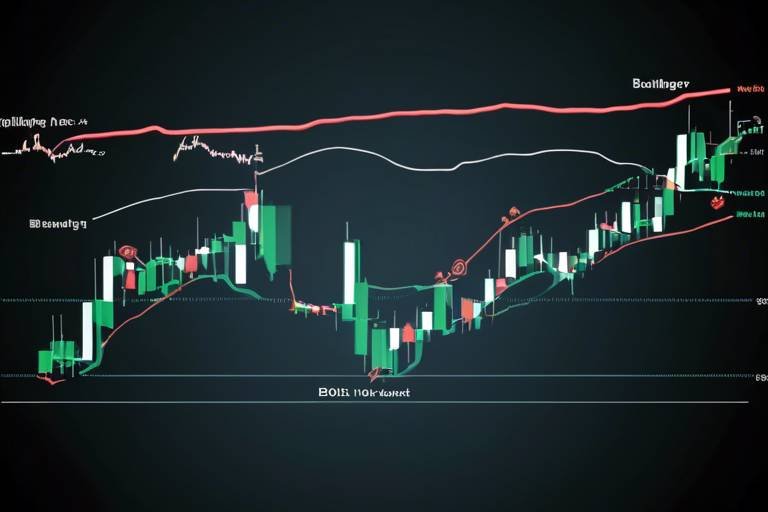Mastering the Art of Diversification in Trading
In the ever-evolving world of trading, one principle stands out as a beacon of hope for traders: diversification. Imagine setting sail on a vast ocean; would you trust your entire journey to just one vessel? Of course not! Similarly, traders must not put all their eggs in one basket. Diversification is the art of spreading your investments across various markets and asset classes to mitigate risks and maximize potential returns. By mastering this art, traders can build a robust portfolio that withstands market fluctuations and enhances their chances of long-term success.
So, why is diversification so crucial? Well, it’s all about risk management. When you diversify, you reduce the impact of any single investment's poor performance on your overall portfolio. For instance, if you have investments in stocks, bonds, and commodities, a downturn in one market may be offset by gains in another. This balance creates a safety net, allowing you to sleep easier at night, knowing that your financial future isn't hanging by a thread.
Moreover, diversification isn’t just a defensive strategy; it can also be a pathway to enhanced returns. By exploring different asset classes and markets, traders can tap into opportunities that they might otherwise miss. Think of it as a buffet of investment options, where you can sample a little bit of everything, rather than being stuck with a single dish that may not satisfy your appetite.
Now, let's delve deeper into the various types of diversification and how they can be integrated into your trading strategy. By understanding these different facets, you can tailor your approach to suit your risk tolerance and investment objectives.
Understanding why diversification is crucial for traders can help minimize risks and enhance portfolio stability. Diversification is not just a buzzword; it's a fundamental principle in trading that can significantly impact long-term success. When you diversify, you create a buffer against volatility. This means that when one asset class is struggling, others may be thriving, providing a balance that can keep your investment portfolio afloat.
Moreover, diversification can lead to better risk-adjusted returns. This means that you can achieve a higher return for the level of risk you are taking. It’s like having a safety harness while climbing a mountain; you can reach greater heights without the fear of falling. By spreading your investments, you can also take advantage of different market cycles, ensuring that you are not overly reliant on one economic condition.
There are various forms of diversification, including asset class, geographical, and sector diversification. Each type plays a crucial role in developing a well-rounded trading strategy. Let’s break these down:
Asset class diversification involves spreading your investments across different categories, such as stocks, bonds, and commodities. This approach helps to reduce overall portfolio risk. By allocating your resources in a balanced manner, you can enhance potential returns while minimizing exposure to any single asset class's volatility.
The benefits of asset class diversification are numerous. For one, it can lead to reduced volatility. When one asset class is underperforming, others may be doing well, which smooths out the bumps in your investment journey. Additionally, it improves your risk-adjusted returns, which means you can achieve better performance relative to the risk you're taking. It's like having a well-rounded diet; a little bit of everything keeps you healthy and strong.
However, it's essential to acknowledge that asset class diversification also comes with its own set of challenges. For instance, you need extensive market knowledge to make informed decisions across various asset classes. Furthermore, there’s a risk of overexposure to certain assets, which can counteract the benefits of diversification. It’s a balancing act, much like walking a tightrope; one misstep can lead to a fall.
Geographical diversification involves investing in markets across different regions and countries. This strategy is vital in managing risks associated with local economic downturns. By spreading your investments globally, you can protect yourself from the adverse effects of political instability or economic crises in any one country. It’s like having a passport that allows you to explore different cultures and opportunities, expanding your horizons and enhancing your investment potential.
Implementing effective diversification strategies is key to successful trading. You can utilize various techniques to ensure a balanced and resilient trading portfolio. For example, consider using Exchange-Traded Funds (ETFs) to gain exposure to multiple asset classes and sectors without the hassle of managing individual stocks. ETFs are like a one-stop-shop for diversification, providing a convenient way to spread your investments.
Another critical strategy is regular portfolio rebalancing. This involves reviewing and adjusting your portfolio to align with your risk tolerance and investment goals. Think of it as a regular tune-up for your car; it keeps everything running smoothly and ensures that you’re on the right track toward your financial destination.
- What is diversification in trading?
Diversification in trading refers to the strategy of spreading investments across various asset classes, sectors, and geographical regions to minimize risks and enhance potential returns. - How does diversification reduce risk?
By not putting all your investments in one basket, diversification helps ensure that poor performance in one area can be offset by better performance in another, thus stabilizing your overall portfolio. - What are the types of diversification?
The main types of diversification include asset class diversification, geographical diversification, and sector diversification. - How often should I rebalance my portfolio?
It's advisable to review and rebalance your portfolio at least once a year or whenever there are significant market changes or shifts in your investment goals.

The Importance of Diversification
When it comes to trading, the phrase "don't put all your eggs in one basket" couldn't be more relevant. Diversification is a critical strategy that every trader should embrace to safeguard their investments and maximize potential returns. But why is diversification so important? Well, think of your trading portfolio as a garden. If you only plant one type of flower, your garden may look beautiful for a while, but it’s also vulnerable to pests or bad weather. On the other hand, by planting a variety of flowers, you increase the chances that at least some will thrive, no matter what happens.
By spreading your investments across different asset classes, sectors, and geographical regions, you can significantly reduce the risks associated with market volatility. For instance, if one sector is experiencing a downturn, another may be flourishing. This balance can help cushion your portfolio against significant losses. Moreover, diversification can lead to enhanced portfolio stability, making it easier to achieve your long-term financial goals. Imagine trying to balance a seesaw; if one side is too heavy, it tips over. Diversification acts as a stabilizer, ensuring that no single investment can swing your portfolio too far in one direction.
Let's explore some key principles that underline the importance of diversification:
- Risk Management: Diversification helps in managing risks by ensuring that not all your investments are affected by the same market events. This can lead to smoother returns over time.
- Potential for Higher Returns: By investing in a variety of assets, you increase your chances of capturing gains from multiple sources, which can lead to higher overall returns.
- Emotional Resilience: A diversified portfolio can help you stay calm during market fluctuations. When one investment dips, others may still perform well, reducing anxiety and impulsive decisions.
In summary, understanding the importance of diversification is essential for any trader aiming for long-term success. It’s not just about mitigating risks; it’s about building a robust portfolio that can weather the storms of market fluctuations while still allowing for growth. So, as you embark on your trading journey, remember that a well-diversified portfolio is your best ally in navigating the complex world of financial markets.

Types of Diversification
Diversification is a powerful strategy that can significantly enhance your trading portfolio. But what exactly does it mean to diversify? In simple terms, it’s about spreading your investments across various dimensions to minimize risk and maximize potential returns. There are several types of diversification that traders can utilize, each with its unique advantages and characteristics.
First off, we have asset class diversification. This involves investing in different categories of assets, such as stocks, bonds, and commodities. Think of it like a balanced diet; just as you wouldn’t want to eat only one type of food, you don’t want to put all your financial eggs in one basket. By spreading your investments across various asset classes, you can reduce the overall risk of your portfolio. For instance, when stocks are performing poorly, bonds may provide stability, thus cushioning your portfolio from significant losses.
Next, there’s geographical diversification. This type is all about expanding your horizons beyond your local market. By investing in different regions or countries, you can mitigate risks associated with local economic downturns. For example, if the economy in your home country takes a hit, your investments in foreign markets may still thrive. This is particularly important in today’s globalized economy, where events in one part of the world can have ripple effects everywhere else.
Then we have sector diversification, which focuses on investing in various industries. Just like a well-rounded team needs players with different skills, a robust portfolio benefits from exposure to multiple sectors. For instance, technology, healthcare, and consumer goods can all behave differently under various economic conditions. If one sector faces challenges, others may still perform well, providing a buffer against losses.
To summarize, the types of diversification can be categorized as follows:
- Asset Class Diversification: Spreading investments across different asset categories.
- Geographical Diversification: Investing in markets around the globe.
- Sector Diversification: Allocating funds across various industries.
Each of these diversification types plays a crucial role in creating a resilient trading strategy. By understanding and implementing them, traders can better navigate the unpredictable waters of the financial markets. Remember, the goal is to build a portfolio that can withstand the tests of time and market volatility.
Q: Why is diversification important in trading?
A: Diversification helps to minimize risk by spreading investments across different assets, sectors, and regions. This way, if one investment performs poorly, others may compensate for those losses.
Q: Can I diversify my portfolio too much?
A: Yes, over-diversification can lead to diminished returns and increased complexity in managing your portfolio. It’s essential to find a balance that works for your investment strategy.
Q: How often should I rebalance my diversified portfolio?
A: It's generally recommended to review and rebalance your portfolio at least annually, or whenever there are significant market movements that affect your asset allocation.

Asset Class Diversification
When it comes to trading, one of the most powerful tools in your arsenal is . Imagine standing on a tightrope, balancing precariously above a sea of uncertainty. Now, what if you had a safety net made up of various assets? That’s what diversification does for your trading portfolio—it cushions you against the inevitable ups and downs of the market. By spreading your investments across different asset classes like stocks, bonds, and commodities, you can significantly reduce your overall portfolio risk while enhancing potential returns.
But why is this strategy so effective? The key lies in the correlation between asset classes. Different assets often react differently to market conditions. For instance, when stocks are soaring, bonds might be lagging, and commodities could be fluctuating. This non-correlation means that when one asset class is underperforming, others may be thriving, allowing you to maintain a more stable overall portfolio value. It’s like having a team of players on a sports field; when one player is off their game, others can step up to secure a win.
To illustrate the significance of asset class diversification, consider the following table that shows how different asset classes have performed over the past decade:
| Asset Class | Average Annual Return (%) | Volatility (%) |
|---|---|---|
| Stocks | 10.5 | 15 |
| Bonds | 5.0 | 5 |
| Commodities | 3.8 | 20 |
| Real Estate | 8.0 | 10 |
As you can see, each asset class has its unique characteristics. Stocks may offer higher returns but come with greater volatility, while bonds provide stability with lower returns. By incorporating a mix of these asset classes, you can create a portfolio that aligns with your risk tolerance and investment goals.
However, while the benefits of asset class diversification are clear, it's essential to recognize that it also brings certain challenges. For instance, you need a solid understanding of each asset class to avoid overexposure to a particular sector. If you’re heavily invested in tech stocks and the tech market takes a hit, your portfolio could suffer significantly. Therefore, it’s crucial to keep an eye on your allocations and adjust them as necessary.
In conclusion, asset class diversification is not just a buzzword; it’s a fundamental principle that every trader should embrace. By spreading your investments across various asset classes, you can mitigate risks and enhance your potential for returns, making your trading journey a lot less daunting. So, whether you’re a seasoned trader or just starting out, remember that a well-diversified portfolio is your best friend in the unpredictable world of trading.

Benefits of Asset Class Diversification
When it comes to trading, the phrase "don't put all your eggs in one basket" couldn't be more applicable. Asset class diversification is like having a safety net for your investments, and it offers a plethora of benefits that can significantly enhance your trading experience. First and foremost, it helps in reducing volatility. Imagine you're riding a roller coaster; some stocks may be soaring while others are plummeting. By spreading your investments across different asset classes such as stocks, bonds, and commodities, you can smooth out those wild ups and downs, leading to a more stable portfolio.
Another significant advantage is the potential for improved risk-adjusted returns. This means that not only are you reducing risk, but you're also positioning yourself to achieve better returns relative to the amount of risk you're taking. For instance, while stocks may offer high returns, they also come with high risks. Bonds, on the other hand, may provide lower returns but typically come with lower risk. By balancing these asset classes in your portfolio, you can enhance your overall performance.
Moreover, asset class diversification allows you to tap into various market opportunities. Different asset classes often perform well under different economic conditions. For example, during inflationary periods, commodities like gold may shine, while bonds might lag. By diversifying, you’re essentially giving yourself a front-row seat to various market trends, which can lead to higher overall returns.
However, it's also essential to understand that asset class diversification can help in mitigating specific risks. For instance, if you invest solely in technology stocks, a downturn in that sector can be devastating. But by diversifying into other sectors such as healthcare or consumer goods, you can cushion the blow from any one sector's poor performance. This approach not only protects your portfolio but also provides peace of mind.
Lastly, asset class diversification can lead to better emotional resilience. Trading can be an emotional roller coaster, and having a diversified portfolio can help you stay calm during market turbulence. When one asset class is underperforming, knowing that others may be doing well can help you avoid rash decisions driven by fear or greed. It's like having a balanced diet; you wouldn't want to eat only pizza every day, right? Just as a balanced diet keeps you healthy, a diversified portfolio keeps your investments robust.
In summary, the benefits of asset class diversification are abundant and vital for any trader looking to navigate the complex landscape of financial markets. By reducing volatility, improving risk-adjusted returns, tapping into various market opportunities, mitigating specific risks, and enhancing emotional resilience, you can create a well-rounded trading strategy that stands the test of time.
- What is asset class diversification?
Asset class diversification refers to the practice of spreading investments across various types of assets, such as stocks, bonds, and commodities, to reduce risk and enhance returns. - Why is diversification important?
Diversification is crucial because it helps to minimize risks associated with market volatility and specific asset performance, leading to a more stable investment portfolio. - How can I diversify my portfolio?
You can diversify your portfolio by investing in different asset classes, sectors, and geographical regions. Using tools like ETFs can also make diversification easier. - What are the risks of not diversifying?
Failing to diversify can lead to significant losses if one asset class underperforms. Concentrating investments in one area increases exposure to market volatility and sector-specific downturns.

Challenges of Asset Class Diversification
While asset class diversification is a powerful strategy for managing risk and enhancing returns, it does not come without its challenges. One major hurdle is the necessity for extensive market knowledge. Traders must be well-versed in various asset classes, including stocks, bonds, commodities, and real estate, to make informed decisions. This requires ongoing research and education, which can be time-consuming and overwhelming, especially for those who are new to trading.
Another challenge is the potential for overexposure to specific assets. Imagine spreading your investments across multiple asset classes but inadvertently placing a significant portion into one particular sector, like technology. If that sector experiences a downturn, your portfolio may still suffer despite your efforts at diversification. This situation highlights the importance of not just diversifying across asset classes but also ensuring that your investments within those classes are balanced.
Moreover, the correlation between different asset classes can fluctuate based on market conditions. For instance, during times of economic uncertainty, assets that typically behave independently may start to move in tandem, leading to increased portfolio risk. Traders must be vigilant and ready to adjust their strategies as market dynamics change. This unpredictability can make it challenging to maintain the desired level of diversification.
Additionally, transaction costs can become a significant factor when diversifying across various asset classes. Each trade incurs fees, and if a trader frequently buys and sells different assets to achieve diversification, these costs can accumulate quickly, eating into potential profits. It's essential to consider these expenses when developing a diversification strategy.
Lastly, emotional biases can play a role in the diversification process. Traders might feel a natural inclination to favor familiar investments or those that have performed well in the past. This bias can lead to an uneven distribution of assets and a lack of true diversification. Overcoming these emotional hurdles requires discipline and a commitment to following a well-thought-out trading plan.
In summary, while asset class diversification is undeniably beneficial, it's crucial to be aware of its challenges. By understanding these potential pitfalls, traders can better navigate the complexities of creating a balanced and resilient portfolio.
- What is asset class diversification? Asset class diversification involves spreading investments across different asset classes, such as stocks, bonds, and commodities, to reduce overall portfolio risk.
- Why is diversification important in trading? Diversification helps mitigate risks associated with market volatility and enhances the potential for stable returns over time.
- How can I ensure my portfolio is properly diversified? Regularly review your investments, maintain a balance across various asset classes, and consider using tools like ETFs to achieve broader exposure.
- What are the common mistakes in diversification? Common mistakes include overexposure to a single asset class, failing to rebalance the portfolio, and allowing emotional biases to dictate investment decisions.

Geographical Diversification
When we think about investing, the first thing that often comes to mind is the stock market. However, limiting ourselves to a single market can be like trying to catch fish in a pond that’s drying up. is the practice of spreading your investments across various regions and countries, allowing you to tap into the growth potential of different economies while mitigating risks associated with local downturns.
Imagine a farmer who only plants one type of crop. If a blight hits that crop, the entire harvest is at risk. Similarly, if you invest solely in your home country, you could face significant losses if that economy falters. By diversifying geographically, you can protect your portfolio from localized economic issues. For instance, if the economy in the U.S. takes a hit, investments in emerging markets like India or Brazil might still perform well, providing a cushion against losses.
One of the key benefits of geographical diversification is the ability to capitalize on different economic cycles. Different countries and regions experience growth at different times. For example, while the U.S. might be in a recession, countries in Southeast Asia could be booming. This asynchronous growth allows traders to shift their focus and investments to regions that are performing well, maximizing potential returns.
However, it’s essential to understand that geographical diversification isn’t without its challenges. Currency fluctuations can significantly impact returns. For instance, if you invest in European stocks and the Euro weakens against your home currency, your returns might diminish even if the stocks perform well. Additionally, political instability in certain regions can pose risks that are not present in more stable economies. Thus, it’s vital to conduct thorough research and consider the economic and political landscapes of the countries you’re investing in.
To effectively implement geographical diversification, you might consider the following approaches:
- Investing in International ETFs: Exchange-Traded Funds (ETFs) that focus on specific regions or global markets can provide an easy way to gain exposure to multiple countries without having to buy individual stocks.
- Global Mutual Funds: These funds pool money from multiple investors to invest in a diversified portfolio of international stocks and bonds.
- Direct Foreign Investments: If you're feeling adventurous, you can invest directly in foreign stocks or real estate, but this requires a deeper understanding of the local markets.
In conclusion, geographical diversification is a powerful strategy for traders looking to enhance their portfolios. By spreading investments across various regions, you not only reduce risk but also position yourself to take advantage of global economic opportunities. Just remember, like any strategy, it requires careful planning and continuous monitoring to ensure that your investments align with your overall financial goals.
Q: What is geographical diversification?
A: Geographical diversification involves investing in different regions and countries to spread risk and capitalize on global economic opportunities.
Q: Why is geographical diversification important?
A: It helps mitigate risks associated with local economic downturns and allows investors to benefit from asynchronous growth in different markets.
Q: How can I achieve geographical diversification?
A: You can invest in international ETFs, global mutual funds, or directly in foreign stocks and real estate.
Q: What are the risks of geographical diversification?
A: Risks include currency fluctuations and political instability in the regions where you invest.

Strategies for Effective Diversification
When it comes to trading, effective diversification is not just a strategy; it’s a necessity. Think of it like a well-balanced meal: you wouldn’t just eat pasta every day, right? You need a mix of proteins, vegetables, and grains to fuel your body effectively. Similarly, a well-diversified trading portfolio can provide the right mix of assets to help you weather market storms and seize opportunities. So, how do you achieve this balance? Let’s dive into some actionable strategies that can help you diversify effectively.
First off, one of the most popular methods for achieving diversification is through the use of Exchange-Traded Funds (ETFs). ETFs are like a basket of different stocks or assets, allowing you to invest in multiple companies or sectors without having to buy each one individually. This not only saves you time but also spreads your risk across various holdings. For instance, if you invest in an ETF that tracks the technology sector, you’re not just betting on one company’s success; you’re investing in a whole range of tech firms. This can significantly reduce the impact of any single stock's poor performance on your overall portfolio.
Another key strategy is regular portfolio rebalancing. Imagine you have a garden where some plants are thriving while others are wilting. If you just let it be, the thriving plants will take over, and the weaker ones will suffer. In trading, the same principle applies. Over time, certain assets may grow faster than others, leading to an imbalance in your portfolio. By regularly reviewing and adjusting your investments, you can maintain your desired level of diversification and ensure that no single asset class dominates your portfolio. This not only helps in managing risk but also aligns your investments with your changing financial goals and risk tolerance.
Moreover, consider sector diversification. Just like in life, where you wouldn’t want to rely solely on one source of income, in trading, it’s wise to invest across different sectors. For example, if you invest only in technology stocks, you might be at the mercy of tech market fluctuations. By diversifying into sectors like healthcare, consumer goods, and energy, you can cushion your portfolio against sector-specific downturns. Each sector reacts differently to economic changes, so having a mix can lead to more stable returns over time.
Lastly, don’t forget about geographical diversification. Investing in international markets can provide exposure to different economic cycles and growth opportunities. For instance, while the U.S. market might be facing a recession, emerging markets could be experiencing robust growth. By spreading your investments across various regions, you can take advantage of global trends and mitigate risks associated with local economic downturns. It’s like having a safety net that catches you when one market falls.
In conclusion, mastering the art of diversification involves a combination of strategies that work in harmony. From utilizing ETFs and rebalancing your portfolio to sector and geographical diversification, these approaches can help you build a resilient trading strategy. Remember, the goal is to create a balanced portfolio that can withstand the ups and downs of the market while maximizing your potential for returns. So, are you ready to diversify and take your trading game to the next level?
- What is the main purpose of diversification in trading? Diversification aims to reduce risk and enhance returns by spreading investments across various assets, sectors, and geographical regions.
- How often should I rebalance my portfolio? It’s generally recommended to review and rebalance your portfolio at least once a year, or whenever there are significant changes in your financial situation or investment goals.
- Can I achieve diversification with a small investment? Yes, using ETFs and mutual funds can allow you to achieve diversification even with a smaller investment by giving you exposure to a wide range of assets.

Using ETFs for Diversification
Exchange-Traded Funds, or ETFs, have revolutionized the way traders approach diversification. Imagine you’re at a buffet, and instead of filling your plate with just one dish, you sample a little bit of everything. That’s what ETFs allow you to do in the investment world. They provide an easy and effective way to gain exposure to a wide range of assets without having to buy each one individually. This is particularly beneficial for those who may not have the time or expertise to analyze multiple stocks or bonds separately.
One of the key advantages of ETFs is their ability to track various indices, sectors, or asset classes. For instance, if you’re interested in technology but don’t want to put all your eggs in one basket by investing in a single tech stock, you can purchase a technology-focused ETF. This ETF will include a variety of companies within the tech sector, spreading your risk across multiple entities. In essence, if one company underperforms, others in the ETF may perform well, thereby cushioning the blow.
Furthermore, ETFs are known for their liquidity. Unlike mutual funds, which are traded only at the end of the trading day, ETFs can be bought and sold throughout the day on an exchange. This feature allows for greater flexibility and responsiveness to market changes. Imagine trying to catch a wave; being able to buy and sell ETFs throughout the day means you can ride the market's ups and downs more effectively.
When it comes to diversification, ETFs can be categorized into several types, including:
- Broad Market ETFs: These track entire markets or indices, such as the S&P 500, giving you exposure to a wide range of sectors and companies.
- Sector ETFs: Focused on specific sectors like healthcare, finance, or technology, allowing you to target particular industries.
- International ETFs: Invest in foreign markets, providing geographical diversification and exposure to global economic trends.
However, while ETFs are a fantastic tool for diversification, it’s crucial to conduct thorough research before investing. Not all ETFs are created equal; some may have high expense ratios or may not track their underlying index effectively. It’s like choosing a ride at an amusement park—you want to make sure it’s safe and worth your time. Always check the ETF’s performance history, fees, and the assets it holds to ensure it aligns with your investment goals.
In conclusion, utilizing ETFs for diversification is not just a smart strategy; it's a practical one. They offer a buffet of investment options that can help you minimize risk while maximizing potential returns. Just remember, like any investment, it’s essential to stay informed and adjust your portfolio as necessary to keep riding those market waves!
Q1: What are ETFs?
ETFs, or Exchange-Traded Funds, are investment funds that are traded on stock exchanges, much like stocks. They hold a collection of assets, such as stocks, bonds, or commodities, and provide a way to invest in a diversified portfolio.
Q2: How do ETFs help with diversification?
ETFs allow investors to buy a single fund that contains multiple assets, reducing the risk associated with investing in individual stocks or bonds. This means that even if one asset performs poorly, others in the ETF may perform well, balancing out potential losses.
Q3: Can I lose money with ETFs?
Yes, like any investment, there is a risk of loss with ETFs. The value of the ETF can fluctuate based on the performance of the underlying assets. It’s important to do your research and understand the risks before investing.
Q4: How often should I review my ETF investments?
It’s advisable to review your investments at least annually or more frequently if there are significant market changes or shifts in your personal financial goals. Regular reviews help ensure your portfolio remains aligned with your risk tolerance and investment objectives.

Regular Portfolio Rebalancing
When it comes to trading, is like giving your investments a much-needed check-up. Just as you might visit a doctor for a routine physical, your portfolio needs to be assessed periodically to ensure it aligns with your financial goals and risk tolerance. Over time, the market can shift, causing certain assets to grow or shrink in value, which can lead to an imbalance in your investment strategy. This imbalance can expose you to unnecessary risks or limit your potential returns.
Imagine you started with a balanced portfolio consisting of 60% stocks and 40% bonds. However, due to a booming stock market, your stocks may now represent 75% of your portfolio. While it sounds great that your stocks are performing well, this higher allocation to stocks increases your exposure to market volatility. Regular rebalancing helps you to realign your portfolio back to your original strategy, maintaining your desired risk level and investment objectives.
So, how often should you consider rebalancing? There isn’t a one-size-fits-all answer, but many traders opt for either a time-based approach or a threshold-based approach. A time-based approach could involve rebalancing on a quarterly or annual basis, regardless of market performance. On the other hand, a threshold-based approach would mean rebalancing only when an asset class deviates from its target allocation by a predetermined percentage. For example, you might decide to rebalance if any asset class exceeds or drops below 5% of its target allocation.
Here’s a quick look at the benefits of regular portfolio rebalancing:
- Risk Management: By rebalancing, you can mitigate risks associated with overexposure to any single asset class.
- Disciplined Investing: It encourages a disciplined investment approach, helping you to stick to your strategy rather than reacting to market emotions.
- Enhanced Returns: Regularly rebalancing can potentially enhance your overall returns by taking profits from high-performing assets and reinvesting them into underperforming ones.
However, it’s essential to keep in mind that rebalancing isn’t without its challenges. Transaction costs can add up, especially if you’re frequently buying and selling assets. Additionally, taxes on capital gains can eat into your profits if you’re not careful. Therefore, it’s crucial to weigh these factors against the benefits of rebalancing. Ultimately, the goal is to maintain a portfolio that reflects your investment philosophy while adapting to market changes.
In conclusion, regular portfolio rebalancing is a vital practice for traders looking to maintain a healthy and effective investment strategy. By keeping your portfolio aligned with your goals and risk tolerance, you can navigate the ever-changing market landscape with confidence. Remember, it’s not just about how much you invest, but how well you manage your investments over time that will determine your long-term success.
- What is portfolio rebalancing? Portfolio rebalancing is the process of realigning the proportions of assets in an investment portfolio to maintain a desired level of risk and return.
- How often should I rebalance my portfolio? It depends on your strategy; some investors rebalance quarterly, while others may do it annually or when asset allocations deviate significantly from targets.
- Are there any costs associated with rebalancing? Yes, transaction costs and potential capital gains taxes can occur when buying and selling assets to rebalance your portfolio.
- Can rebalancing improve my investment returns? Yes, by taking profits from high-performing assets and reinvesting in underperformers, rebalancing can enhance overall returns over time.
Frequently Asked Questions
- What is diversification in trading?
Diversification in trading refers to the strategy of spreading investments across various assets, markets, or sectors to minimize risk. By not putting all your eggs in one basket, you can potentially reduce the volatility of your portfolio and enhance your chances of achieving stable returns.
- Why is diversification important for traders?
Diversification is crucial because it helps mitigate risks associated with market fluctuations. When one asset underperforms, others may perform better, balancing out potential losses. This approach fosters long-term stability and can lead to improved overall portfolio performance.
- What are the different types of diversification?
There are several types of diversification, including:
- Asset Class Diversification: Investing in different asset classes like stocks, bonds, and commodities.
- Geographical Diversification: Spreading investments across various regions and countries.
- Sector Diversification: Allocating funds to different industry sectors to avoid concentration risk.
- How can I achieve asset class diversification?
You can achieve asset class diversification by investing in a mix of stocks, bonds, real estate, and commodities. This balance helps to reduce overall portfolio risk and can lead to better risk-adjusted returns.
- What are the benefits of geographical diversification?
Geographical diversification allows you to manage risks related to local economic downturns. By investing in different regions, you can protect your portfolio from adverse conditions that may affect a specific area, ensuring a more balanced investment approach.
- How often should I rebalance my portfolio?
It's generally recommended to review and rebalance your portfolio at least once a year. However, if there are significant market changes or if your investment goals shift, you may want to rebalance more frequently to maintain your desired level of diversification.
- What role do ETFs play in diversification?
Exchange-Traded Funds (ETFs) are a fantastic tool for achieving diversification, as they allow investors to purchase a basket of assets in a single transaction. This means you can easily gain exposure to various asset classes and sectors, making it simpler to build a diversified portfolio.
- Are there any risks associated with diversification?
While diversification can reduce risk, it doesn't eliminate it. Over-diversification can lead to lower returns and increased complexity in managing your portfolio. It's essential to find the right balance that aligns with your investment strategy and risk tolerance.



















